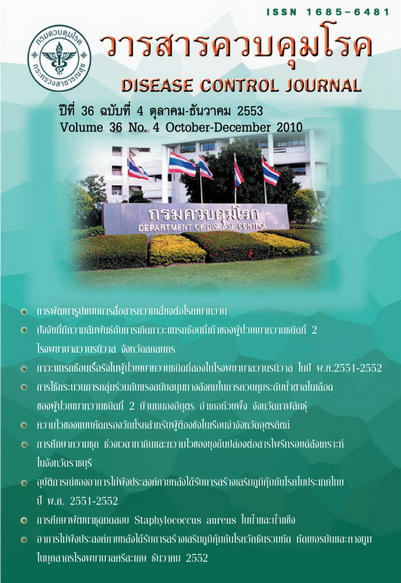The Prevalence, Biting Time of Anopheles spp. and its Susceptibility to Synthetic Pyrethroids in Ratchaburi Province
Keywords:
Species, Density and Susceptibility, Synthetic Pyrethroids, Anopheles mosquitoesAbstract
The objectives of this research were to delineate the prevalence biting time and susceptibility of Anopheles moquitoes to synthetic pyrethroids (Permetrin 0.75% and Deltamethrin 0.05%) in transmission areas of Ratchaburi province. The mosquitoes were collected in June July and October by light trap during 18.00-24.00 PM inside and outside the houses. The susceptibility test was done following WHO methods. The results showed that the most common species were A. minimus, A. maculates, A. dirus and A. barbirostris with prevalence rates of 48.15, 25.93, 14.81 and 11.11 percent, respectively. The susceptibity of A. minimus in all areas to Permethrin 0.75% . The mortality rates after exposure to Permethrin 0.75% were 98-100 percent while those of Deltamethrin 0.05% were 99-100 percent. The using synthetic pyrethroids (Permethrin and Deltamethrin) for Anopheles mosquitoes control is still effective in these areas. Therefore Malaria vectors and susceptibility test to insecticides should be should be studied as a sentinel surveillance. However, chemical using to control Malaria should be under control of experts to avoid the chemical resistance of .vectors.
Downloads
References
2. สำนักระบาดวิทยา กรมควบคุมโรค. สถานการณ์โรคมาลาเรีย. ได้จาก http://203.157.15.4/surdata / disease.php?ds=30 (วันที่ค้นข้อมูล 17 เมษายน 2551).
3. สำนักโรคติดต่อนำโดยแมลง กรมควบคุมโรค. คู่มือการใช้สารเคมี เครื่องพ่นสารเคมี และการบำรุงรักษาในงานควบคุมโรคติดต่อนำโดยแมลง. กรุงเทพฯ: โรงพิมพ์ชุมนุมสหกรณ์การเกษตรแห่งประเทศไทย จำกัด; 2547.
4. World Health Organization. Vector Resistance to Pesticides. WHO Technical Report Series 818. Geneva 1992; 3-6.
5. จีรวรรณ ชงจังหรีด. การติดตามความต้านทานต่อสารฆ่าแมลง 3 ชนิดของยุงก้นปล่อง (Anopheles minimus Theobald) ในอำเภอแม่สอด จังหวัดตาก. (วิทยานิพนธ์) ขอนแก่น: มหาวิทยาลัยขอนแก่น; 2546.
6. World Health Organization. Test Procedures for Insecticide Resistance Monitoring in Malaria Vectors, Bio-Efficacy and Persistence of Insecticides on Treated Surfaces. Report of the WHO Informal Consultation. 1988; 11-17.
7. สงวนเกียรติ โรจน์ฤทัย. เทคนิคทางกีฎวิทยาภาคสนามในงานควบคุมโรคติดต่อนำโดยแมลง. เอกสารประกอบการอบรมเจ้าหน้าที่ปฏิบัติงานกีฎวิทยาภาคสนาม; ไม่ปรากฏแหล่งพิมพ์; ไม่ปรากฏปีที่พิมพ์.
8. ศุภลาภ พวงสะอาดและคณะ. สำรวจแหล่งเพาะพันธุ์ของยุงก้นปล่องและสภาพนิเวศวิทยาของลูกน้ำในเขตพื้นที่ตำบลตะนาวศรี อำเภอสวนผึ้ง จังหวัดราชบุรี. วารสารอายุรศาสตร์เขตร้อนและปาราสิตวิทยา 2549; 29(2): 56-64.
9. Sumruayphol S, Apiwathnasorn C, Komalamisra N, et al. Bionomic status of Anopheles epiroticus Linton & Harbach, a coastal malaria vector, in Rayong Province, Thailand. Southeast Asian J Trop Med Public Health 2010; 41(3): 541-7
10. ปิยะพร หวังรุ่งทรัพย์และคณะ. ความไวของยุงก้นปล่องต่อสารเคมีสังเคราะห์ไพรีทรอยด์ด้วยวิธีองค์การอนามัยโลกและวิธีชีวเคมี. วารสารอายุรศาสตร์เขตร้อนและปาราสิตวิทยา 2550; 30(2): 68-75.
11. วิชัย สติมัย และคณะ. การศึกษาความไวต่อสารเคมีของยุงลายบ้านและยุงก้นปล่องในภาคตะวันออก ปี 2550. เข้าถึงได้จาก http://dpc3.ddc.moph.go.th/in_tranet/Insect/ Research%20Data / Susceptibility2007.mht (วันที่ค้นข้อมูล 1 มิถุนายน 2551).
Downloads
Published
How to Cite
Issue
Section
License
Articles published in the Disease Control Journal are considered as academic work, research or analysis of the personal opinion of the authors, not the opinion of the Thailand Department of Disease Control or editorial team. The authors must be responsible for their articles.


.png)



